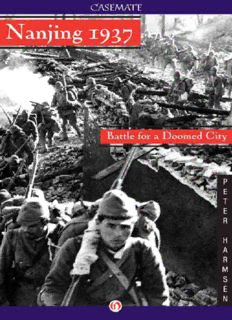
Nanjing 1937 Battle for a Doomed City PDF
Preview Nanjing 1937 Battle for a Doomed City
Nanjing 1937 Battle for a Doomed City Peter Harmsen Contents Author’s Note PROLOGUE 1 A NEW BATTLE BEGINS CHAPTER 2 “MOVING OUT!” CHAPTER 3 THE LINE IS CROSSED CHAPTER 4 BATTLE AT LAKE TAI CHAPTER 5 WINTER CHAPTER 6 ENEMY AT THE GATES CHAPTER 7 DECISIVE DAYS CHAPTER 8 THE FALL CHAPTER 9 TERROR CHAPTER 10 AFTERMATH CHAPTER APPENDIX ORDERS OF BATTLE Acknowledgments Notes Image Gallery Bibliography Maps China and Northeast Asia: 1937 Lower Yangtze Area: Late 1937 Nanjing: Late 1937 Japanese Advance: Middle of November, 1937 Japanese Advance: Late November, 1937 Battle of Jiangyin Battle of Lake Tai Japanese Advance on Nanjing: Early December, 1937 Akao Junzo’s Battle: December 3, 1937 Nanjing Area: Before Final Storm of City Battle for The Gate of Enlightenment: December 10, 1937 Fall of Nanjing Author’s Note T have been hotly HE PROS AND CONS OF THE PINYIN SYSTEM OF TRANSLITERATION debated. However, the fact is that in the early 21st century it is far more commonly used than any competing system and, therefore, it has been adopted in this book, with only a few exceptions where other more traditional spellings are used universally. For example, China’s ruler at the time is referred to as Chiang Kai-shek, not Jiang Jieshi, and China’s longest river is the Yangtze, not the Changjiang. I have also opted to refer to the Chinese capital by its pinyin spelling, Nanjing. In a few instances, especially in direct quotes, the spelling more common at the time, Nanking, has been preserved. More generally, geographical names are given in their modern form rather than in the form common in 1937, so they are more recognizable to the reader (e.g. Beijing instead of Beiping and Taiwan instead of Formosa). In a few cases, I have decided to provide direct translations of Chinese place names, for example, Purple Mountain instead of Zijinshan or Gate of Enlightenment instead of Guanghua Gate. The main purpose is to make the text easier for the non-Chinese speaker to follow. It is the custom in China to place the family name (usually one syllable) first, followed by the given name (usually two syllables). This custom has been followed in this book. For Japanese names, I also follow the Japanese practice of putting family names first. Despite advice from Japanese linguists, I have refrained from using diacritic marks to indicate the length of vowels. This is because I wish to make the text easier on the eye. This book is the result of lengthy research using a large number of mainly first-hand sources. The narrative has been constructed using this source material and is the result of a long series of individual choices. Each of these choices could have turned out differently had another writer been at work, and the end result would have been a very different book. I welcome discussion of the choices I have made. The easiest way is to visit my website www.chinaww2.com or my Facebook page, www.facebook.com/chinaww2. Only through a frank and open debate will we be able to gradually approach that elusive and essentially unachievable object—to recount history as it really was. Prologue D 1937 early 1938, URING THE COURSE OF SIX TERRIBLE WEEKS IN LATE AND Nanjing was transformed from a name into a symbol. Nanjing, or Nanking as it was known in the West at the time, became the victim of the intense and indiscriminate violence of a victorious army bent on revenge. Its helpless people were subjected to rape and murder on a scale that maintains its capacity to shock, even in a world that has since been exposed only too often to man’s ability to inflict pain on fellow human beings, from Nazi-occupied Europe in the early 1940s to Cambodia in the 1970s and Rwanda in the 1990s. Like these places, Nanjing has become instantly recognizable as a chapter in the thick book of 20th-century terror. The lengthy battle for Nanjing, the five-week campaign that preceded the six weeks of slaughter, is much less known to the Western public, and for that matter the Chinese public as well. Chiang Kai-shek’s army, consisting of soldiers from all over the continent- sized nation, put up a determined fight to make the Japanese invader pay as high a price as possible for every inch of Chinese soil he conquered. Nanjing 1937 is remembered as a tale of Chinese victimhood, but prior to that it was also a tale of Chinese heroism. Like many other Second Sino-Japanese War battles, it deserves, but
Description: